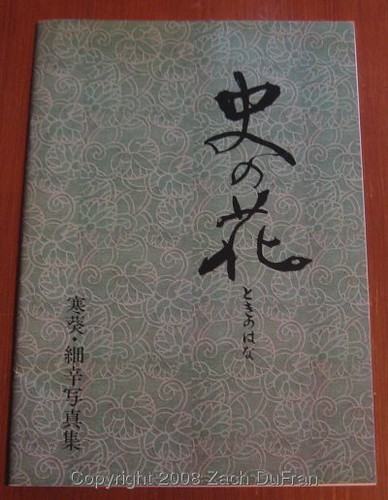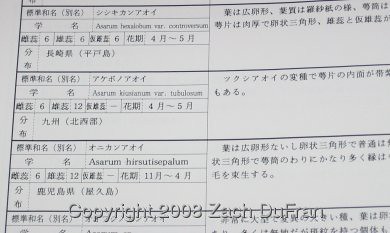Doesn't that title just draw you in? No?
Well, maybe that explains why everyone was rolling their eyes when I opened this Christmas present from my parents (which I had requested, by the way). The Japanese book "Toki No Hana" is a 45 page monograph (book with one subject) with 480 photographs of plants from the genus
Asarum.
 |
| Toki No Hana cover |
Although I have only grown one species from this genus, I greatly admire the genus and I have plans to start a small collection. In the United States,
Asarum are grown most often as groundcovers in woodland shade gardens in the north. There are a couple of species native to North America. You might run across their mottled foliage in the woods of the northern states and in Canada.
In southeast Asia, it's a completely different matter. For thousands of years, the Japanese have cultivated different varieties for their variable foliage and subtle, but beautiful blooms. The foliage can be anywhere from solid green to almost completely silver. The blooms vary from yellow with red centers to solid purple. They are treasured plants, grown in small pots where they can show off their blooms most easily. You see, the inflorescence of an
Asarum is at the base of them stem, literally lying on the surface of the soil (or pebbles in the pictures below). One of the most recognized blooms looks like a little panda bear, being white and a deep purple that looks black.
 |
| Asarum pictures from Toki No Hana |
The book was compiled by the Japanese Asarum Preservation Society and is a collection of pictures of all of the different varieties that have been cultivated there. It is fascinating to see the variation. Some are stunning and others are... well, not so pretty. After all of the pictures are several pages of notes on the identification and origin of the different species and cultivars presented in the pictures. Of course, the notes are in Japanese:
 |
| Notes on Asarum species - did you get all that? |
Thankfully, my parents purchased this book from a US source (
Asiatica Nursery) that had grabbed a bunch of these books in Japan and translated the notes to English.
 |
| Ah, much better. Asarum notes translated from Japanese to English by Barry Yinger. |
This Spring I will be checking the Atwoods store here in town where I have purchased
Asarum splendens in the past. I will probably get three or four plants to start with. Since
Asarum are actually a cool climate plant and will do very well in dimly lit, cool rooms, my plan is to start my collection in earnest this Fall by purchasing several more varieties from
Asiatica Nursery, an online retailer that specializes in
Asarum. They usually have about 70 different varieties available. I already have a short list of the plants I plan to purchase:
Asarum kiusianum var. tubulosum - solid white flowers, low clumping leaves
Asarum maximum Green panda wild ginger - one of the most famous species
Asarum splendens Chinese wild ginger - the variety I will buy at Atwood's in town
Asarum subglobosum - pink/beige flowers, green leaves have center white stripe
Asarum takaoi ‘Ginba’ - solid silver leaves
Asarum wulingense
It will be great fun to watch my plants mature into specimens as beautiful as those pictured in Toki No Hana and to see my plants produce some of these amazing inflorescences.
Stay tuned for pictures of my plants as I collect them!




Wow that is really cool....thanks for sharing, ah, those
ReplyDeleteAsians! Like myself I am half Korean ;) hehe
Very interesting. Even the cover of the book is pretty. Be sure to show us what you choose!
ReplyDeleteZach:
ReplyDeleteI was most intrigued by this post as I have only heard of this book once before. Its spectacular - based on what you have let us see!
I started with the wild Canadian ginger but found it to be in direct competition with a Sanguinaria canadense (bloodroot) - lets just say the bloodroot won out! This didn't mean the end of my journey through the genus Asarum. I have A. splendens, and it is truly .... splendid, for lack of a better word!
I have added you to my fave list as well! Happy posting!
Glad the book is interesting and will help with your new collection. It is surprising they have these plants at Atwoods.
ReplyDelete